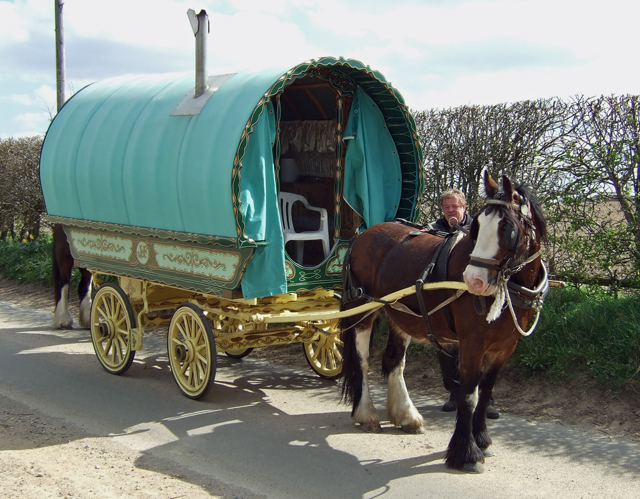But throughout this major questions have been at the back of my mind: what were the Landywood Great Stones? What had they looked like before they were ever moved to make way for coal-mining? Were we ever looking at the decimation of Great Wyrley's answer to Stonehenge?

Did Holly Lane ever look like this?
Landywood: The Placename Evidence
The Great Stones might be gone, but often ancient monuments can leave their mark in other ways. For example, there are dozens of places called Barrow Hill in Britain. Most of them are associated with prehistoric burial sites (aka barrow or low). Those which aren't probably did have one in their past. When a large stone circle is around, then roads and local businesses tend to get named after them. It ripples out around the site, visible even if the monument itself is removed.
This is no less true in Great Wyrley and Landywood. During the English Civil War, a group of soldiers dug a well on the hill. The track that originally led to it is still called Wharwell (war + well) Lane. Some time back in the 6th or 7th century, an isolated pocket of Celts remained in Saxon occupied territory. They built a hall, which has long since disappeared. We know it's there because a town name still refers to it - the Welsh Hall, aka Walsall. Wyrley's Walsall Road goes all the way to it. Brook Lane is built alongside a brook. There used to be a very large field, which Broadmeadow Lane snaked around. So on and so forth.
So imagine what would have happened if Great Wyrley grew around an ancient monument the size of Stonehenge. It would surely have been mentioned.
But it wasn't. Beyond all of Homeshaw and Sambrook's talk of 'druidic temples', we know precisely what was notable in the area. The placename evidence is loud and clear on the subject. It was bog myrtle and bushes.
The Etymology of Great Wyrley and Landywood
As late as the 18th century, travellers to the area would have found whole swathes of a rare bog myrtle. It only grew here. It's gone now, cut into extinction by the coal-mining, but it was once the most startling sight. The Saxons called it Gagel (pronounced Gale); the Celts called it Wir. Hence we get Gailey - the gagel field. Hence we get Wyrley - the wir field.
Just in case we missed that for lack of Old English and Welsh linguistics, we have some pointers in modern English. The main lane through this is still called Gorsey Lane. It cut through gorse bushes. It went around Broom Hill. That would refer to the gorse broom.
On the other side of Gorsey Lane was Gorway Moor. I'll admit to some problems pinpointing the etymology of the name here. It could be a moor named after someone with the surname Gorway. It might be Gorse-way, ie an area made completely of gorse. It might have a darker name - gore-way, with implications of once being a battlefield back when the Saxons were fighting the Danes. The 'gor' or 'ger' was also an ancient Germanic term for a spearhead. Gorway might be an older name yet. The Celts might have called it gwag or gweigion, which means 'empty' - an apt name for a moor.
Personally, I think it was probably the gorse.
Finally you get Landywood, which is extremely simple to translate. 'Wood' speaks for itself, while the prefix comes from the Old English 'launde', which meant 'glade'. The 'y' part implies someone lives there, so Landywood means 'dwellers in the glade in the wood'.
Every pre-modern placename in the vicinity of the Landywood Great Stones paints a picture of the landscape. It talks about moors, myrtle, gorse broom bushes and glades. It does not mention an ancient monument of any description.
Local Legends About the Landywood Great Stones
Another great source of information, pointing towards the presense of an ancient monument, are the local legends. Stonehenge has thousands of them, like Merlin flying the stones through the air to put them there. Others talk of giants throwing earth or rocks. I've searched, there are no legends of this ilk anywhere near Great Wyrley.
There are also more pragmatic histories or cultural references. Things that happened in or around ancient monuments, which point to the stones as a background setting. Again there is nothing regarding that in Great Wyrley.
Gypsies and the Great Stones in Holly Lane
The closest that we've got is a comment, from a reader in one of my earlier blog entries. He said that his father called one of the Landywood Great Stones a gypsy's cook stone. That did check out. The Great Wyrley Review, produced by the Great Wyrley Local History Society (2011), includes a note that Gypsy caravans were parked in Holly Lane in 1958. The council tried to evict them, but they refused to go. More caravans arrived and it was quite the drama at the time.
They aren't there now, but maybe it left a vague memory in his father's mind, which became associated with the stone that remains there. Or maybe the Travellers did use it to cook or serve food on, back in the 1950s.
The Landywood Great Stones Were Not Wyrley's Stonehenge
Having hunted through the entire history sources at both Great Wyrley and Cannock Libraries, plus Paul Ford having searched Walsall Local History Archives, there is little to suggest that the Landywood Great Stones were an ancient monument. At least they weren't a 'druidic temple' nor anything close to Stonehenge.
Next time, I'll tell you exactly what I think they were.


Go to the link below.
ReplyDeletehttp://www.british-history.ac.uk/os-1-to-10560/staffordshire/057/nw
You will see on the map the place where those stones once stood.
Here is a picture of where they were dumped -
ReplyDeletehttps://wyrleyblog.files.wordpress.com/2014/07/the-great-stones-of-landywood-from-great-wyrley-1051-1951.png
This may further help -
ReplyDeletehttps://wyrleyblog.wordpress.com/wyrley-landywood/the-origins-of-great-wyrley/